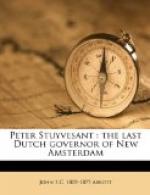And now for ten years there had been peace with the Indians, when a gross outrage again roused their savage natures to revenge. The Indians, ever accustomed to roam the forest, and to gather fruits, nuts and game wherever they could find them, had not very discriminating views of the rights of private property. Ensign Van Dyck, the former treasurer, and one of the most noted men in the colony, detected an Indian woman in his orchard gathering peaches. Inhumanly he shot her dead. This roused all the neighboring tribes, and they united to avenge her death. There was certainly something chivalrous in this prompt combination of the warriors not to allow, what they deemed the murder of a sister, to pass unpunished.
Taking advantage of the absence of Governor Stuyvesant, with nearly all the military force he could raise, on his expedition to the South river, sixty-four war canoes, containing nineteen hundred armed Indians, were at midnight on the fifteenth of September, stealthily paddled into the waters surrounding fort Amsterdam. They were picked warriors from eight tribes. The night was dark, and the sighing of the wind through the tree tops and the breaking of the surf upon the beach added to the deep repose of the sleepers.
The Indians landed and stealthily crept through the silent streets; and yet, from some unexplained cause, they made no attack. Gradually the inhabitants were awakened, and there was a rapid assembling of the principal men within the fort. Several of the chiefs were called before them. They gave no satisfactory account of the object of their formidable visit, and uttered no threats. On the contrary they promised to withdraw before night, to Nutten Island, as Governor’s island was then called. Still, watching their opportunity, one of the warriors pierced the bosom of Van Dyck with an arrow.
The cry of murder rang through the streets. The inhabitants were prepared for the not unexpected emergency. The military rushed from the fort, and a fierce battle ensued. The Indians, leaving three of their warriors dead in the streets, and having killed five white men and wounded three others, were driven to their canoes, and crossed over the North river to the Jersey shore.
And now their savage natures burst forth unrestrained. The flourishing little villages of Pavonia and Hoboken were instantly in flames. A general scene of massacre and destruction ensued. Men, women and children fell alike before the bullet, the arrow and the tomahawk. The inhabitants of fort Amsterdam in anguish witnessed the massacre, but could render no assistance. Nearly all their armed men were far away on the Delaware.
The savages, elated with success, crossed over to Staten island. The scattered settlements there numbered about ninety souls. There were eleven farms in a high state of cultivation, and several plantations. The settlers had received warning of their danger, perhaps by the flames and musketry of Hoboken and Pavonia, perhaps by some messenger from fort Amsterdam. Sixty-seven of them succeeded in reaching some stronghold where they were able to defend themselves. The rest, twenty-three in number, were cut off by the savages. The buildings of twenty-eight farms and plantations were laid in ashes and the crops destroyed.




